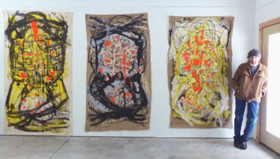Michael Luchs: Fictitious Character Opens May 11 At The Museum Of Contemporary Art Detroit (MOCAD)
By: Julie Musbach Mar. 05, 2018

Courtesy of Michael Luchs and Museum of Contemporary Art Detroit (MOCAD) DETROIT - March 5, 2018 - The Museum of Contemporary Art Detroit (MOCAD) is pleased to announce Fictitious Character, a solo exhibition of the work of Michigan-based artist Michael Luchs, opening Friday, May 11, 2018. This survey constitutes the largest presentation of Luchs's work to date. The exhibition will remain on view through Sunday, July 29, 2018.
A selection of the artist's works will fill MOCAD's Central and DEPE Space galleries. Luchs's paintings and sculptures are heavily worked and reworked, sometimes over the course of many years. They feature layers of color and texture, forming collages of unique gestures, which reflect both his iconic style and the aesthetic of Detroit's Cass Corridor movement of the 1960s and 1970s. Like many of his fellow Cass Corridor artists, Luchs's work embodies a raw and frenetic romanticism, an energy that frames the unique fabric of his art-whether on paper, board, or canvas, often filled with scrappy renditions of animals or ovoid forms. Some works are backed with duct tape or framed on delicate wire-rolled paper, the found and scavenged materials gesturing at the ongoing collapse of the industrial center that surrounded him in his early years as an artist.Michael Luchs (b. Portsmouth, Ohio 1938) was among the celebrated Detroit Cass Corridor painters and sculptors in the 1960s and 1970s. Luchs graduated from Olivet College (Olivet, Michigan) in 1961, and attended the University of Michigan in 1964 before moving to Detroit, where he studied at Wayne State University (1966-68). His work is part of several collections including the Detroit Institute of Arts, Wayne State University James Duffy Collection, University of Michigan Museum of Art (UMMA), and the Cranbrook Academy of Art Museum, as well as private collections throughout the United States. He was recently part of the 2017 Invitational Exhibition of Visual Arts at the American Academy of Arts and Letters, in New York, where he was the recipient of the Academy's 2017 Art and Purchase Award. ABOUT MOCAD
The Museum of Contemporary Art Detroit (MOCAD) is an innovative addition to Detroit's vibrant Midtown neighborhood, and functions as a hub for the exploration of emerging ideas in the contemporary arts. As a non-collecting institution, MOCAD is responsive to the cultural content of our time, fueling crucial dialogue, collaboration, and public engagement. The Museum is located between the Detroit Symphony Orchestra and the Detroit Institute of the Arts, Wayne State University, and the College for Creative Studies. The cavernous 22,000 square foot building, a former auto dealership, has been simply renovated to maintain its raw historic character. MOCAD's ambitious series of public programs includes lectures, musical performances, films, literary readings and educational activities for area youth. Mobile Homestead, by late artist Mike Kelley, is a permanent artwork located on the grounds of the museum. It is both a public sculpture and a private, personal construction - based on the artist's childhood home on Palmer Road in Westland. The ground floor serves as a community event space by and for a diverse public, as Kelley intended. MOCAD is generously supported by individual members, private and corporate foundations, and government agencies. More information can be found at mocadetroit.org
Photo: Courtesy of Michael Luchs and Museum of Contemporary Art Detroit (MOCAD)
Videos

